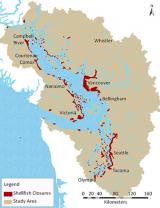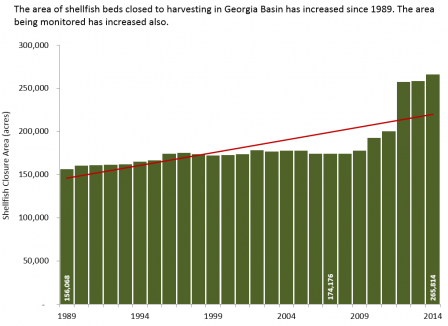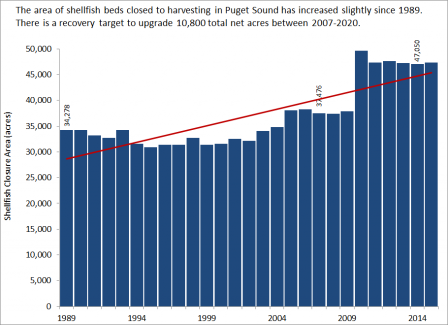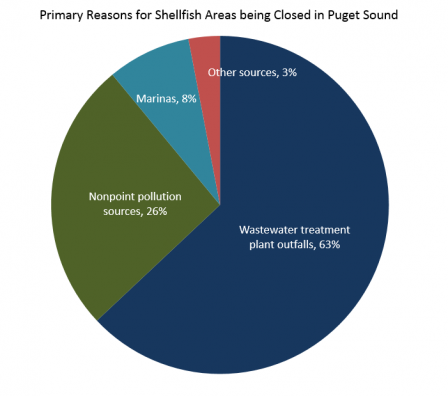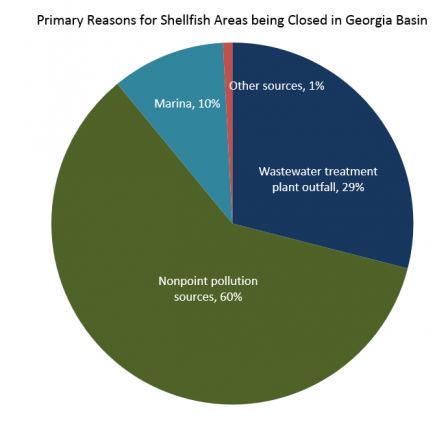Shellfish Harvesting
Summary
Neutral
Between 2007 and 2016, over 3,800 acres of previously closed shellfish beds in Puget Sound have been upgraded or re-opened due to improvements in water quality. However, there has also been an overall increase in the number of acres of shellfish beds that are prohibited or restricted from harvesting. This increasing trend is due partly to increased water quality monitoring, changes in classifying closed areas and methods of mapping beach closures.
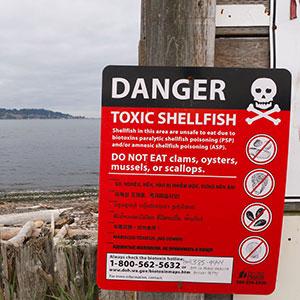
Shellfish are an important part of the economy, lifestyle and heritage of this region. The Salish Sea is home to an abundance of clams, mussels, and oysters and other bivalve shellfish. Because they feed by filtering the water that washes over the shellfish bed, they can accumulate disease-causing bacteria and viruses that are harmful to people.
Shellfish beaches are assigned a classification that determines whether shellfish in that area are safe to eat. The classification is based on the results of a local sanitary survey and water quality monitoring. If monitoring shows poor water quality, or if the sanitary survey identifies potential impacts to water quality - such as being located too close to a wastewater treatment outfall - then the shellfish beach may be closed to harvesting.
- Learn more about shellfish beach classifications
Shellfish beach classifications are similar in both the U.S. and Canada. Commercial growing areas and recreational growing areas have slightly different classification names, but the standards are similar. Commercial harvest is not allowed in areas that are not classified.
Approved - This classification applies to areas that are safe for harvesting based on the sanitary survey. This classification authorizes commercial shellfish harvest for direct marketing.
Conditionally Approved - This classification means an area is safe for harvesting except during certain periods. The length of the closed periods is based on water sample data that show how long it takes for safe harvesting conditions to return to that area.
Restricted - When the sanitary survey shows a limited degree of pollution, including from non-human sources, the area may be classified as restricted. Shellfish harvested commercially from restricted growing areas cannot be marketed directly. They must be transplanted to approved growing areas for a specified amount of time, allowing shellfish to naturally cleanse themselves of contaminants before they are harvested for market.
Prohibited – This classification applies to growing areas near sewage treatment plant and industrial outfalls, marinas, and other pollution sources. Commercial shellfish harvests are not allowed from prohibited areas.
Marine water quality samples are collected throughout the year to support shellfish bed classifications. Shoreline surveys are conducted less frequently, but each year dozens of shellfish growing areas are surveyed to evaluate all potential sources of pollution that may impact water quality in that area.
What's happening?
In 2014, over 265,000 acres (1075 square kilometers) of shellfish beds were closed to harvesting in the Georgia Basin, and about 47,000 acres (190 square kilometers) were closed in Puget Sound (see map). These values include all areas that are prohibited, restricted, or have only conditional approval for commercial harvest.
- Learn more about what's happening
Since 1989 in the Georgia Basin, the area of tidal lands closed to shellfish harvesting has steadily increased by 41%. However, this is mostly due to increased monitoring efforts and refinements in designating closure areas. (see chart below - click for larger view)
Since 1989 in Puget Sound, the area of tidal lands closed to shellfish harvesting has increased by 27%. However, since 2007, the number of acres of shellfish beds upgraded in classification has increased. While these upgrades may not all result in beach openings, they reflect efforts toward recovery. (see chart below - click for larger view).
Why is it important?
This region is one of the largest producers of shellfish in North America. Areas that are closed to shellfish harvesting can impact the livelihood of growers, workers, supermarkets, restaurants, hotels, and sales of recreational equipment, among other economic losses. Shellfish closures also impact First Nation and tribal shellfish harvesting rights, which have been part of their traditions and economies for thousands of years.
- Learn more about why it's important
Recreation is another important economic factor associated with shellfish harvesting. In 2005, the Washington Department of Fish and Wildlife collected nearly $1.5 million in licensing fees for shellfish and seaweed.
Shellfish also help improve water clarity by filtering the water, provide food for animals in higher food webs, and create space to allow more light for eelgrass to grow - which provides a crucial nursery for many marine animals.
Why is it happening?
The primary sources of pollution that lead to closure of shellfish harvesting areas are polluted runoff from urban areas and farms, and uncontrolled sources of sewage and septic wastes.
Urbanization creates more roads and other impervious surfaces that can become "super highways" for oil, grease, chemicals, fertilizers, pet waste, sediment and other pollution when it rains. Likewise, manure and agricultural chemicals that are not properly treated or controlled by farms can end up in our waterways and impact shellfish growing areas.
Sewage from malfunctioning or aging treatment plants and failure of home septic systems can release human waste and other dangerous bacteria and pathogens into shellfish-growing areas. Some marinas and boaters also release untreated sewage to water.
- Learn more about why it's happening
The following chart shows why shellfish beaches in Puget Sound were classified as prohibited for harvesting in 2014:
- 63% were near wastewater treatment plant outfalls. Note: Most prohibited areas around wastewater outfalls are based on the potential for pollution and not actual water quality.
- 26% were impacted or potentially impacted by nonpoint pollution sources such as poorly functioning on-site sewage systems (septic), farms, wildlife, and other potential sources.
- 8% were near marinas. Note: Prohibited areas around marinas are based on the number of boats and their potential to contribute pollution, not actual water quality.
- 3% were prohibited based on other sources.
In contrast, the primary reason for the closure of shellfish beds in Georgia Basin during the same period was nonpoint pollution. Proximity to sources of urban and agricultural runoff, and seepage from septic fields resulted in the closure of 60% of shellfish areas. The presence and potential impacts from wastewater treatment plant outfalls contributed to the closure of 29% of shellfish beds. Marinas and other sources such as wildlife and hinterland drainage.
What's being done?
Government agencies are working with local stakeholders to create shellfish protection districts and develop strategies for preventing and responding to harvest closures. Tribes in Washington and First Nations in British Columbia are leading community partnerships that target pollution sources. In both the U.S. and Canada, many shellfish growers belong to trade associations which foster environmental responsibility and effective stewardship of shellfish growing areas.
- Learn more about what's being done
Puget Sound
In Puget Sound, the total area of downgraded shellfish beaches has decreased over time (see graph below). The Puget Sound Partnership has set a target to upgrade 10,800 total net acres (44 square kilometres) in Puget Sound between 2007 and 2020.
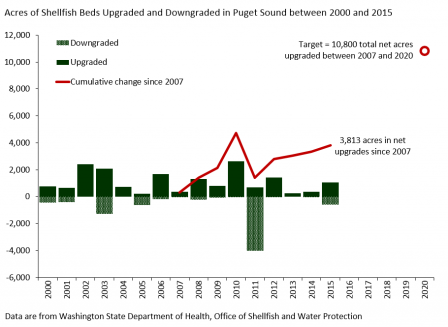 The Washington Department of Health (under the U.S. National Shellfish Sanitation Program) conducts sanitary surveys in shellfish growing areas and closes harvest areas when there is a threat to public health. These surveys include a shoreline evaluation to identify pollution sources that may impact water quality, sampling to determine bacteria levels in the water, weather conditions, tides and other factors that may affect the distribution of pollution in the area.
The Washington Department of Health (under the U.S. National Shellfish Sanitation Program) conducts sanitary surveys in shellfish growing areas and closes harvest areas when there is a threat to public health. These surveys include a shoreline evaluation to identify pollution sources that may impact water quality, sampling to determine bacteria levels in the water, weather conditions, tides and other factors that may affect the distribution of pollution in the area.Georgia Basin
In the Georgia Basin, the Canadian Shellfish Sanitation Program mandates a partnership in which Fisheries and Oceans Canada opens and closes shellfish areas on the recommendation of either Environment Canada or the Canadian Food Inspection Agency (CFIA). CFIA maintains the biotoxin surveillance program and monitors the processing of edible shellfish for compliance with federal standards.
Environment Canada monitors the level of fecal contamination in shellfish growing areas, identifies nearby pollution sources that could impact these areas, and recommends growing water classifications for approval by the Pacific Region Interdepartmental Shellfish Committee.
In 2012, new Wastewater System Effluent Regulations came into force in Canada that reduced pollution from wastewater treatment plants and led to improved water quality to help reduce shellfish beach closures. The new regulations required upgrades to secondary wastewater treatment at two facilities in MetroVancouver, including the Lions Gate Wastewater Treatment Plant in North Vancouver, and the Iona Island Wastewater Treatment Plant in Richmond. The cost of upgrades is estimated at $1.4 billion. The governments of Canada, British Columbia, and Capital Regional District also recently announced a new wastewater treatment system for Greater Victoria with an estimated total capital cost of $782.7 million.
Five things you can do to help
- Scoop your pet's poop. Pet waste is full of bacteria that can get washed into waterways and make people sick if they eat contaminated shellfish. Bag it and place it in the trash.
- If you're a boater, manage your sewage wastes properly. Do not discharge treated or untreated sewage into our waterways. Many marinas provide sewage pumpout as a free or low cost service.
- If your home or business uses a septic system, take time to learn how your system works and keep it properly maintained. Ask for maintenance advice from your local health agency.
- Use techniques such as natural landscaping, rain gardens, rain barrels, green roofs and permeable paving to help reduce the need for chemical fertilizers and reduce runoff into ditches and storm drains.
- Do your part to dispose of unused medicine and chemicals properly. Never dump into household toilets and sinks or outside where they can get into ditches or storm drains. See if your community has a household hazardous waste drop-off facility that will take your old or unused chemicals.
Related information
The following links exit the site Exit
- Washington Department of Health Shellfish Program
- Environment Canada Marine Water Quality Program
- U.S. Food and Drug Administration National Shellfish Sanitation Program
- Canadian Shellfish Sanitation Program
- Puget Sound Partnership Vital Signs - Shellfish Beds Reopened
- MetroVancouver Integrated Liquid Waste and Resource Management Plan
- Capital Regional District Wastewater Treatment Program (Canada)
- Canada 2012 Wastewater Systems Effluent Regulations
Scientific references
The following links exit the site Exit
- US Food and Drug Administration. 2011. National Shellfish Sanitation Program. Accessed April 25, 2012.
- Canadian Food Inspection Agency. 2011. Canadian Shellfish Sanitation Program. Accessed April 25, 2012.

